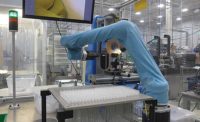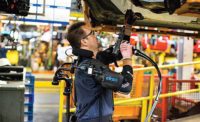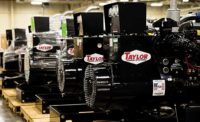Lean Gives Crown Equipment a Lift
Continuous improvement and a vertical manufacturing strategy enable Crown to compete in a crowded market.








If a pallet-load of stuff must be moved around a warehouse, factory or retailer somewhere in the world, chances are pretty good that the machine doing the heavy lifting was made by Crown Equipment Corp.
Brothers Carl and Allen Dicke founded Crown in New Bremen, OH, in 1945. Seventy-six years later, Crown is one of the largest producers of lift trucks and material handling equipment in the world, with more than $3 billion in annual sales.
Today, the fourth generation of the Dicke family runs the company—James Dicke II is chairman and James Dicke III is president. The company’s global headquarters remains in New Bremen, with regional headquarters in Australia, China, Germany and Singapore. Crown operates 19 manufacturing locations and 500 service and distribution sites in more than 80 countries. It employs more than 16,200 people worldwide, including 10,800 across the United States.
“I’m honored to be a part of this company and the reputation we have earned for working closely with our customers to enhance efficiency, productivity and safety. We could not have reached this point without the support of the communities where we reside and our employees, who are an incredible group of people dedicated to our customers’ success,” says James Dicke III. “It’s exciting to think about what the company will accomplish in the next 75 years.”
In 2007, Forbes magazine called Crown the “BMW of fork trucks,” and it’s not hard to see why. The company has a history of developing advanced technology for material handling. Most recently, the company expanded its internal combustion line of counterbalance forklifts, introduced the InfoLink 7-inch touch-screen display, and announced a line of lithium-ion-powered forklifts. In 2019, Crown debuted the ESR 1000, the first lift truck equipped with the company’s new Gena operating system, which is designed to give operators, managers and service technicians a slew of performance data.
Recently, we sat down with David Tumbusch, Crown’s director of manufacturing, to talk about lean, vertical integration and Industry 4.0.
ASSEMBLY: Crown was named among Forbes magazine’s best employers in 2019. What makes your company one of America’s best?
Tumbusch: It’s our culture. Our employees are engaged, they help each other, and they strive to meet customer needs. That doesn’t happen by accident. We invest in employee development. We have a dedicated training team and a host of training modules to help employees advance in their careers. We continue to enhance and add to these programs so the training remains relevant to current and future assignments. As Crown continues to grow, new career opportunities will become available, and our development program is preparing employees for those opportunities.
ASSEMBLY: Can you give us an example of a training module?
Tumbusch: We have a training module for new employees that teaches them about the company, our history and culture. It even introduces them to some of our retirees from the company's early days. The idea is to give employees a historical perspective on the company and some insight into company philosophy.
ASSEMBLY: Crown makes up to 85 percent of the components used in its material handling equipment. What are the advantages of being vertically integrated?
Tumbusch: One advantage is flexibility. We can be a lot more agile in resolving the customer’s needs. We’re less constrained by the designs of externally provided components, and we’re less reliant on external supply chains. Throughout the pandemic, we didn’t have to shut down our assembly lines.
Another advantage is quality. We take ownership of the manufacturing process and our components. Being vertically integrated allows constant interaction between our design and manufacturing teams so they can resolve any issues early.
A third advantage is sustainability. We can better leverage opportunities to maximize resources. We are always looking for ways to minimize the use of resources, yet still provide the right solution for the customer.
Consistency is another advantage. We maintain global production standards across all our operations. That enables us to apply best practices to all our processes, regardless of where they are located.
One final advantage of vertical integration may not be readily apparent, and that’s career opportunities for our employees. Being vertically integrated, we’re not limited to assembly processes. We do machining, electronics manufacturing and other processes, as well, so our employees can take their career down any path they like.
ASSEMBLY: What assembly technologies have made a big impact on your operations?
Tumbusch: One that comes to mind is smart fastening tools. These tools provide data that we were unable to see before. Knowing how a particular nut or bolt has been tightened helps ensure that our assembly process is running as designed.
ASSEMBLY: Lean manufacturing has played a big role in making Crown’s factories more efficient. Can you offer any lean advice?
Tumbusch: One thing I would suggest to organizations beginning their journey is to ask, why do they want to be lean? That’s important, because you need to explain to employees why they’re undertaking the process. It creates positive engagement.
After that, the best thing to do is just to get started. Start small and work toward achieving successes. Those successes will build momentum that will encourage others to participate. Don’t make lean projects too big. Large projects take too long, which makes it difficult for employees to see the end result. Start by implementing a 5S program. That accomplishes two things: It tells the organization that something’s different, and it’s an opportunity to engage employees at all levels.
I would also teach employees to see the eight wastes, so they’re better prepared to identify improvement opportunities. Kaizen events are a very good way to develop teams and engage employees in the improvement process. Don’t focus on removing employees. Employees won’t participate if they feel you’re just using lean to eliminate their jobs.
Finally, I would encourage manufacturers to benchmark others. Go see how other companies have identified waste and made improvements. Learning is an essential part of the lean journey.
ASSEMBLY: Crown engineers spend time in the field watching how the company’s products perform. How has that helped design your products?
Tumbusch: It helps us understand how operators use our trucks and what they need to do their jobs better. The example that comes to mind is when we introduced our side-stance reach trucks, which give the operator a much wider viewing area.
Another example is when we introduced a 7-inch touch-screen display. By watching operators, we could provide them with much more—and better—information to do their jobs. What’s interesting about the 7-inch display is that it offers onboard coaching. This can help to change incorrect behaviors and reinforce the right ones. The display can also provide a visual safety checklist.
ASSEMBLY: Several Crown facilities have earned “zero-landfill” status. Why do that? Can you offer any advice for manufacturers that might also want to do that?
Tumbusch: We want to be environmentally responsible and a good steward of resources. It’s part of our long-term view, and at the end of the day, it’s just the right thing to do for future generations. As we develop our products, our design teams work with manufacturing and purchasing to identify opportunities to minimize the amount of resources needed to make and use our products.
For an organization that’s just starting out, the first thing I would suggest is to review your waste streams. Look at the waste you are generating and where it’s coming from. That will help you prioritize opportunities and identify where to start. My other suggestion is to engage your employees. They may already have ideas, and they are already engaged with household recycling programs.
It’s just like implementing lean. Benchmark other organizations. Start small and build momentum.
ASSEMBLY: What manufacturing challenges do you expect in the future?
Tumbusch: That’s an interesting question. I don’t think anyone could have predicted something like the pandemic, for example. Looking back, our vertical integration strategy helped us respond, and we will be able to apply many of the lessons learned during the past year to future challenges.
One challenge we continue to deal with is developing our skilled workforce. For instance, how do we incorporate technologies like additive manufacturing so we can respond more quickly to customer needs? That’s a challenge not just for Crown but for every manufacturer. How can we promote manufacturing as a career? Many people don’t think of manufacturing as a career, but there are exciting things happening in our industry. Manufacturers need to develop relationships with vocational schools, technical schools and universities to promote manufacturing careers. Crown works closely with the leadership of local educational institutions, and we offer an apprenticeship program.
Finally, another challenge for manufacturers will be how to avoid getting overwhelmed with the amount of data that’s becoming available from our processes. Manufacturers will need to find the right balance in this age of “Big Data.” We have started working on Crown’s version of the “smart factory.” We are developing interfaces and connection points, and we are making data available across all of our operations worldwide. But, we have to regularly ask ourselves: How can we use this data to make our operation better? How can we use this data to make our employees’ jobs easier and better? Does it improve the quality of our product?
Looking for a reprint of this article?
From high-res PDFs to custom plaques, order your copy today!










